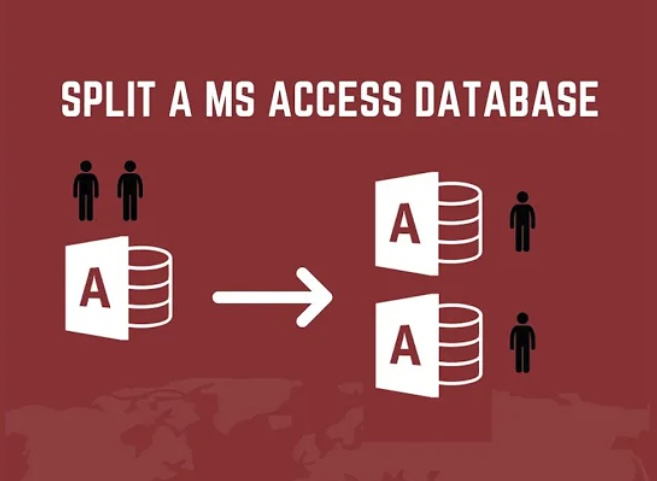Efficiency and performance are crucial in managing databases. Although small to medium businesses favor Microsoft Access for its user-friendliness, the system tends to slow down as databases grow larger. To overcome this issue, splitting your Access database into two is a recommended solution that offers exceptional scalability and optimum efficiency. This involves separating the front end from the back end of your database resulting in improved performance levels.
What is a Split Access Database?
The front-end and back-end of the divided Access database are two different files. As so, the portion of the database that consists of all data tables together with a portion of the front-end that includes reports, forms, queries, and application logic becomes a component of the back-end. It allows users to access information simultaneously without any hindrance from distorted or contradicting data problems.
Why Should You Split Your Access Database?
The great benefits of splitting an Access database into front-end and back-end components are many, to be precise. This includes improved performance, enhanced security, easier maintenance, and an element of scalability. Let us look at each of these in great detail:
- Performance Enhancement: Dividing the database would enhance performance by lowering interface loading times and minimizing load on local machines, as solely the front-end application is loaded.
- Improved Security Measures: By utilizing an enabled server for the backend, unauthorized access to data is prevented and users can rest assured that their information remains secure.
- Ease of site maintenance: Site maintenance is made easy as updates and upkeep can be done smoothly on the back-end, without causing any interruption to users accessing the front-end.
- Scalability: Performance remains unaffected with the addition of more users, demonstrating scalability.
How to Split Your Access Database
Here’s a step-by-step guide to efficiently split your Access database:
Backup Your Database
Prior to commencing the splitting process, ensure that you create a backup of your existing database as a precautionary measure in case any unforeseen issues arise along the way. This will serve as an assurance for you and enable you to revert back to the initial state at any given time.
- To begin, launch Microsoft Access and click on the “File” tab located in the menu bar.
- You can choose either the “Save As” or “Backup Database” option.
- Choose a name and provide details of the location for the backup file.
- Before proceeding with the database splitting, make sure that the backup process is completed successfully.
Create a New Database for the Back-End
After ensuring the safety of one’s backup, it is necessary to create a new database that can serve as the backend for dividing Access databases.
- Launch Microsoft Access and select “Blank Database” from the ‘File’ menu.
- Assign a relevant title to your fresh database and store it in any location of your choosing.
- Proceed to transfer all of your data tables from the original database to this newly established backend database at present.
- To accomplish this task, navigate to the source database and select the specific tables that need to be migrated by right-clicking on them. Afterwards, opt for either “Export” or “Copy to Another Database”.
- Choose the recently formed database and proceed with completing all remaining instructions to transfer data. It is important to create linked tables within the front-end database that reference those in the back-end, thereby ensuring successful execution.
Configure the Front-End
After completing the back-end database setup, it’s time to configure the front end of your Access database split.
- In order to preserve the user interface and functionality of the application, it is important to keep its original database (front-end) containing the application forms, reports, queries, and macros intact.
- Connect the tables of the back-end database to the front-end database for unrestricted accessibility and effortless manipulation of information.
- Hover over the desired data type you wish to link or import within the Access External Data tab’s group, and then select either ODBC Database or Access.
- To create a connection between the front-end and back-end databases, comply with the instructions by choosing which tables to associate with the front-end. Ensure that the link is accurately set up so that all essential tables can be accessed from it.
Best Practices for Managing a Split Access Database

To guarantee data integrity, security and peak performance while managing a split Access database, it is crucial to adhere to the best practices. The following are some recommended guidelines that should be followed:
Regular Backups
To ensure complete protection of your data and prevent loss caused by hardware failure, corruption, or unexpected incidents, it is important to have a routine backup. It is imperative that both the front-end and back-end files are backed up for comprehensive coverage.
| Backup Frequency | Backup Method |
| Weekly | Use built-in backup tools or scripts. |
| Daily | Consider automated backup solutions. |
| On Database Changes | Implement triggers for immediate backups. |
Secure the Back-End
To ensure the security of your split Access database back-end, it’s imperative to prevent access by unauthorized individuals who cannot maintain confidentiality. You can enhance security measures through various actions including:
- Access Controls: Ensure that only authorized users are granted access to the backend database. This involves a two-step process of authentication and authorization, which determines each user’s level of clearance according to their designated role and responsibilities.
- Sensitive data encryption: Utilized to safeguard sensitive information stored in the database from unauthorized access or disclosure during a security breach, as well as individuals who are not granted authorization to view this type of content.
Monitor Performance
Consistently monitoring database performance enables you to identify and address possible hindrances or ineffectiveness that may impact user satisfaction. Employ various tracking methods, such as assessing query execution times, resource usage, and throughput to monitor performance metrics efficiently. Actively pursue optimizing your system’s efficiency by implementing these techniques effectively.
- Query Optimization: Evaluate the SQL queries and enhance their efficiency by reducing execution time.
- Indexing: Improving query performance can be achieved by creating appropriate indexes for the tables, allowing data to be retrieved at a faster rate.
- Resource Allocations: To effectively manage the workload, it’s important to make sure that adequate resources are allocated to the backend server.
Update Efficiently
For a successful update of a split Access database, it is essential to ensure proper coordination between its front-end and back-end components. To accomplish this, consider the following crucial steps:
- Version control: Make sure to have version control for both front-end and back-end files, this will allow easy updating in case of any changes. It would also facilitate quick rollback if necessary.
- Testing: Before deploying any changes in the production environment, it is crucial to conduct thorough testing of all updates in the development or staging environment. This will help prevent potential risks and minimal disruptions.
- Deployment Plan Development: Create a deployment strategy that outlines the sequence of actions for updating front-end and back-end components, incorporating stakeholder input to ensure seamless transition with minimal disruption.
Conclusion
To boost your database’s performance, scalability, and security, divide your Access database. Adhering to the suggested policies and top methods specified earlier guarantees that your system fulfills present requirements while also anticipating potential expansion and hurdles. This methodology empowers enterprises to optimize their data use resulting in enhanced decision-making ability as well as better overall efficiency.
FAQ
Even small systems can gain advantages from splitting because it enhances data organization and boosts the application’s response time.
Make sure that all links leading to the back-end are accurately established. If issues persist, it may be beneficial to seek guidance from a Microsoft Access database specialist.
While having a basic knowledge of Access is enough to split a database, being acquainted with the structure of databases and familiar with the features in Access can aid in ensuring a seamless transition.
The frequency of updates is contingent upon the specific requirements of your enterprise and the extent to which data modifications occur. Consistent updating effectively sustains performance and safeguards data integrity.




